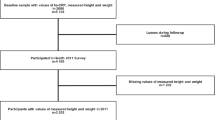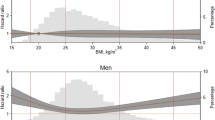Abstract
Objective:
Elevated levels of inflammation factors often precede weight loss and may be causally related to it. Newer studies suggest that elevated levels of inflammation factors also precede weight gain. In this study, we examined whether inflammation factors are elevated in individuals, age ⩾65 years, who lost or gained >5% weight over a 3 year follow-up period compared to those with stable weight.
Subjects:
In total, 3254 participants in the Cardiovascular Health Study whose weight was stable; 661 who gained >5% weight; and 842 who lost >5% weight.
Measurements:
C-reactive protein (CRP), fibrinogen, factor VIIIc, white blood cell (WBC) and platelet counts, and interleukin-6 (IL-6) levels.
Results:
As compared to participants whose weight was stable, those who lost >5% weight had higher baseline CRP concentration (1.05 (95% CI, 1.02, 1.08) per interquartile increase) and WBC count (1.10 (1.01, 1.19) per interquartile increase) on adjusted analyses. Those who gained >5% weight had higher baseline CRP (1.05 (1.01, 1.08)), fibrinogen (1.13 (1.01, 1.27)), and factor VIIIc (1.15 (1.03, 1.30)).
Conclusions:
Inflammation factors are associated with weight gain and weight loss in older individuals. These findings suggest that subclinical inflammation, or unknown factors associated with subclinical inflammation, contribute to weight change.
This is a preview of subscription content, access via your institution
Access options
Subscribe to this journal
Receive 12 print issues and online access
$259.00 per year
only $21.58 per issue
Buy this article
- Purchase on Springer Link
- Instant access to full article PDF
Prices may be subject to local taxes which are calculated during checkout
Similar content being viewed by others
References
Newman AB, Yanez D, Harris T, Duxbury A, Enright PL, Fried LP, Cardiovascular Study Research Group. Weight change in old age and its association with mortality. J Am Geriatr Soc 2001; 49: 1309–1318.
Roberts SB, Fuss P, Heyman MB, Evans WJ, Tsay R, Rasmussen H et al. Control of food intake in older men. JAMA 1994; 272: 1601–1606.
Sharma R, Anker SD . Cytokines, apoptosis and cachexia: the potential for TNF antagonism. Int J Cardiol 2002; 85: 161–171.
Mitch WE . Cachexia in chronic kidney disease: a link to defective central nervous system control of appetite. J Clin Invest 2005; 115: 1476–1478.
Das UN . Is obesity an inflammatory condition? Nutrition 2001; 17: 953–966.
Duncan BB, Schmidt MI, Chambless LE, Folsom AR, Heiss G, Atherosclerosis Risk in Communities Study Investigators. Inflammation markers predict increased weight gain in smoking quitters. Obes Res 2003; 11: 1339–1344.
Barinas-Mitchell E, Cushman M, Meilahn EN, Tracy RP, Kuller LH . Serum levels of C-reactive protein are associated with obesity, weight gain, and hormone replacement therapy in healthy postmenopausal women. Am J Epidemiol 2001; 153: 1094–1101.
Engstrom G, Hedblad B, Stavenow L, Lind P, Janzon L, Lindgarde F . Inflammation-sensitive plasma proteins are associated with future weight gain. Diabetes 2003; 52: 2097–2101.
Hotamisligil GS . Inflammatory pathways and insulin action. Int J Obes Relat Metab Disord 2003; 27 (Suppl 3): S53–S55.
Willerson JT, Ridker PM . Inflammation as a cardiovascular risk factor. Circulation 2004; 109 (21 Suppl 1): II 2–II 10.
Browning LM . N-3 Polyunsaturated fatty acids, inflammation and obesity-related disease. Proc Nutr Soc 2003; 62: 447–453.
Aronson D, Sella R, Sheikh-Ahmad M, Kerner A, Avizohar O, Rispler S et al. The association between cardiorespiratory fitness and C-reactive protein in subjects with the metabolic syndrome. J Am Coll Cardiol 2004; 44: 2003–2007.
Tracy RP, Psaty BM, Macy E, Bovill EG, Cushman M, Cornell ES et al. Lifetime smoking exposure affects the association of C-reactive protein with cardiovascular disease risk factors and subclinical disease in healthy elderly subjects. Arterioscler Thromb Vasc Biol 1997; 17: 2167–2176.
Barzilay JI, Abraham L, Heckbert SR, Cushman M, Kuller LH, Resnick HE et al. The relation of markers of inflammation to the development of glucose disorders in the elderly: The Cardiovascular Health Study (CHS). Diabetes 2001; 50: 2384–2389.
Fried LP, Borhani NO, Enright P, Furberg CD, Gardin JM, Kronmal RA et al. The Cardiovascular Health Study: design and rationale. Ann Epidemiol 1991; 1: 263–276.
Cushman M, Cornell ES, Howard PR, Boville EG, Tracy RP . Laboratory methods and quality assurance in the Cardiovascular Health Study. Clin Chem 1995; 41: 264–270.
Fried LP, Ettinger WH, Lind B, Newman AB, Gardin J . Physical disability in older adults: a physiological approach. Cardiovascular Health Study Research Group. J Clin Epidemiol 1994; 47: 747–760.
Barzilay JI, Spiekerman CF, Wahl PW, Kuller LH, Cushman M, Furberg CD et al. Prevalence of clinical and isolated subclinical cardiovascular disease in older adults with glucose disorders. The Cardiovascular Health Study. Diabetes Care 2001; 24: 1233–1239.
Schwartz MW, Woods SC, Porte D, Seeley RJ, Baskin DC . Central nervous system control of food intake. Nature 2000; 404: 661–671.
Suganami T, Nishida J, Ogawa Y . A paracrine loop between adipocytes and macrophages aggravates inflammatory changes: role of free fatty acids and tumor necrosis factor alpha. Arterioscler Thromb Vasc Biol 2005; 25: 2062–2068.
Seals DR, Bell C . Chronic sympathetic activation – consequence or cause of age-associated obesity? Diabetes 2004; 53: 276–284.
Hanley AJ, Festa A, D’Agostino Jr RB, Wagenknecht LE, Savage PJ, Tracy RP et al. Metabolic and inflammation variable clusters and prediction of type 2 diabetes: factor analysis using directly measured insulin sensitivity. Diabetes 2004; 53: 1773–1781.
Duncan BB, Schmidt MI, Pankow JS, Ballantyne CM, Couper D, Vigo A et al. Atherosclerosis Risk in Communities Study: low-grade systemic inflammation and the development of type 2 diabetes: the Atherosclerosis Risk in Communities Study. Diabetes 2003; 52: 1799–1805.
Acknowledgements
This study was supported by contracts NO1-HC-85079 through NO1-HC-85086, NO1-HC-35129, and NO1-HC-15103 from the National Heart, Lung, and Blood Institute.
Author information
Authors and Affiliations
Corresponding author
Appendix
Appendix
Odds ratios for the association of inflammation factors with weight gain using logistic regression. Values are per interquartile higher values of baseline inflammation factors. Table A1
Rights and permissions
About this article
Cite this article
Barzilay, J., Forsberg, C., Heckbert, S. et al. The association of markers of inflammation with weight change in older adults: the Cardiovascular Health Study. Int J Obes 30, 1362–1367 (2006). https://doi.org/10.1038/sj.ijo.0803306
Received:
Revised:
Accepted:
Published:
Issue Date:
DOI: https://doi.org/10.1038/sj.ijo.0803306
Keywords
This article is cited by
-
The interaction between rs 3,807,992 genotypes with the dietary inflammatory index on Leptin, Leptin resistance, and Galectin 3 in obese and overweight women
BMC Endocrine Disorders (2022)
-
The association of high-sensitivity C-reactive protein with future weight gain in adults
International Journal of Obesity (2022)
-
Genetic pleiotropy underpinning adiposity and inflammation in self-identified Hispanic/Latino populations
BMC Medical Genomics (2022)
-
Association between depression, anxiety and weight change in young adults
BMC Psychiatry (2019)
-
Maternal Sleep in Pregnancy and Postpartum Part II: Biomechanisms and Intervention Strategies
Current Psychiatry Reports (2019)



